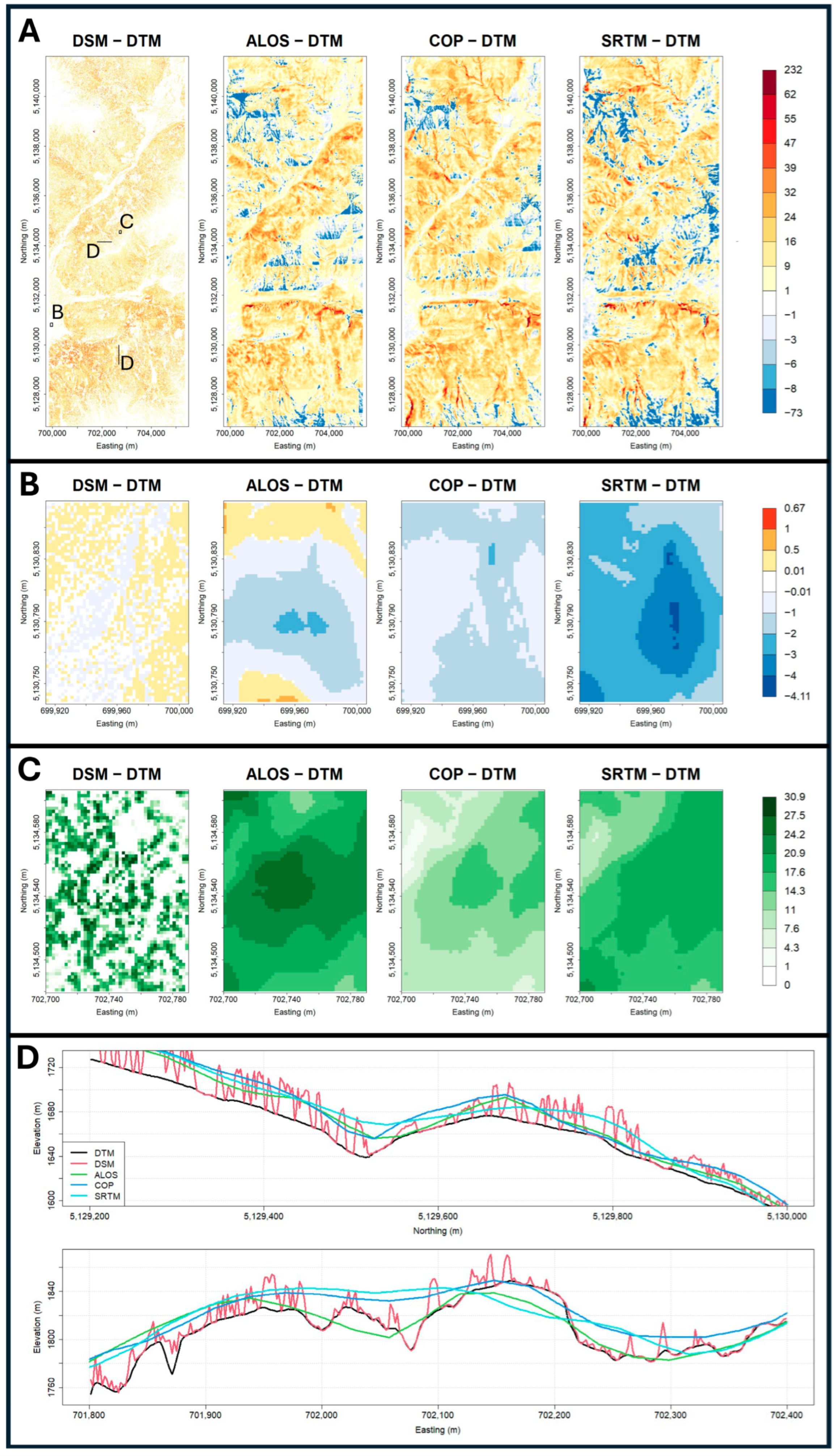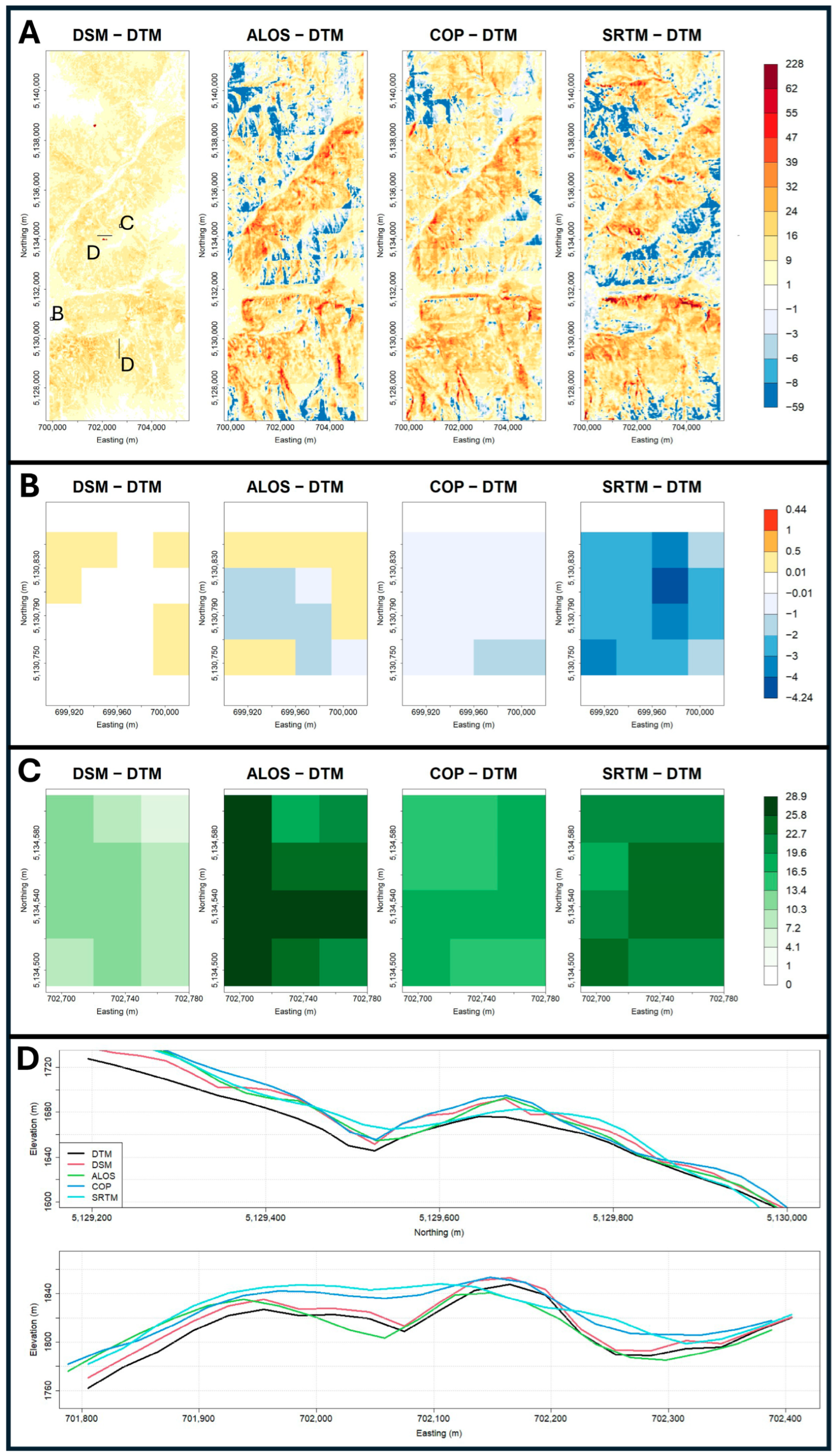Effect of DEM Used for Terrain Correction on Forest Windthrow Detection Using COSMO SkyMed Data
Abstract
:1. Introduction
2. Materials and Methods
2.1. Materials
2.1.1. Study Area and Reference Data
2.1.2. SAR Data
2.1.3. Digital Elevation Models
2.2. Methods
2.2.1. Calibration
2.2.2. Terrain Correction
2.2.3. Windthrow Detection Algorithm
3. Results
4. Discussion
5. Conclusions
Author Contributions
Funding
Data Availability Statement
Acknowledgments
Conflicts of Interest
References
- Flores-Anderson, A.I.; Parache, H.B.; Martin-Arias, V.; Jiménez, S.A.; Herndon, K.; Mehlich, S.; Meyer, F.J.; Agarwal, S.; Ilyushchenko, S.; Agarwal, M.; et al. Evaluating SAR Radiometric Terrain Correction Products: Analysis-Ready Data for Users. Remote Sens. 2023, 15, 5110. [Google Scholar] [CrossRef]
- Zhao, L.; Chen, E.; Li, Z.; Fan, Y.; Xu, K. Radiometric Terrain Correction Method Based on RPC Model for Polarimetric SAR Data. Remote Sens. 2023, 15, 1909. [Google Scholar] [CrossRef]
- Shiroma, G.H.X.; Lavalle, M.; Buckley, S.M. An Area-Based Projection Algorithm for SAR Radiometric Terrain Correction and Geocoding. IEEE Trans. Geosci. Remote Sens. 2022, 60, 5222723. [Google Scholar] [CrossRef]
- Jiang, W.; Yu, A.; Dong, Z.; Wang, Q. Comparison and Analysis of Geometric Correction Models of Spaceborne SAR. Sensors 2016, 16, 973. [Google Scholar] [CrossRef]
- Chen, X.; Sun, Q.; Hu, J. Generation of Complete SAR Geometric Distortion Maps Based on DEM and Neighbor Gradient Algorithm. Appl. Sci. 2018, 8, 2206. [Google Scholar] [CrossRef]
- Kropatsch, W.G.; Strobl, D. The Generation of SAR Layover and Shadow Maps from Digital Elevation Models. IEEE Trans. Geosci. Remote Sens. 1990, 28, 98–107. [Google Scholar] [CrossRef]
- Li, X.; Zhang, G.; Yin, C.; Wu, Y.; Shen, X. A Novel Shadow and Layover Segmentation Network for Multi-Angle SAR Images Fusion. IEEE Access 2022, 10, 117770–117781. [Google Scholar] [CrossRef]
- Du, X.; Yang, Q.; Cai, B.; Liang, D. A New Method on Shadow and Layover Detection of InSAR. In Proceedings of the 2017 Sixth Asia-Pacific Conference on Antennas and Propagation (APCAP), Xi’an, China, 16–19 October 2017; pp. 1–3. [Google Scholar]
- Farr, T.G.; Rosen, P.A.; Caro, E.; Crippen, R.; Duren, R.; Hensley, S.; Kobrick, M.; Paller, M.; Rodriguez, E.; Roth, L.; et al. The Shuttle Radar Topography Mission. Rev. Geophys. 2007, 45, 2005RG000183. [Google Scholar] [CrossRef]
- Michael, A.; Bailey, B.; Hiroji, T.; Hato, M. The ASTER Global DEM. Photogramm. Eng. Remote Sens. 2010, 76, 344–348. [Google Scholar]
- EORC, J. ALOS Global Digital Surface Model (DSM). ALOS World 2021, 1, 1–21. [Google Scholar]
- Fahrland, E. Copernicus DEM Product Handbook (v4.0); Airbus Defence and Space GmbH: Taufkirchen, Germany, 2022. [Google Scholar]
- Rosario, J.; Shiroma, G.H.X.; Fattahi, H.; Meyer, F.; Jeong, S. Assessment of Terrain Dependence of Radiometric Terrain Corrected C-Band Sentinel-1 SAR Backscatter over Different Target Types. In Proceedings of the IGARSS 2023—2023 IEEE International Geoscience and Remote Sensing Symposium, Pasadena, CA, USA, 16–21 July 2023; pp. 4286–4289. [Google Scholar]
- Filipponi, F. Sentinel-1 GRD Preprocessing Workflow. Proceedings 2019, 18, 11. [Google Scholar] [CrossRef]
- CEOS. Analysis Ready Data for Land: Normalized Radar Backscatter 2021. Available online: https://ceos.org/ard/files/PFS/SAR/v1.1/CEOS-ARD_PFS_Synthetic_Aperture_Radar_v1.1.pdf (accessed on 15 November 2024).
- Rüetschi, M.; Small, D.; Waser, L.T. Rapid Detection of Windthrows Using Sentinel-1 C-Band SAR Data. Remote Sens. 2019, 11, 115. [Google Scholar] [CrossRef]
- Lazecky, M.; Wadhwa, S.; Mlcousek, M.; Sousa, J.J. Simple Method for Identification of Forest Windthrows from Sentinel-1 SAR Data Incorporating PCA. Procedia Comput. Sci. 2021, 181, 1154–1161. [Google Scholar] [CrossRef]
- Dalponte, M.; Solano-Correa, Y.T.; Marinelli, D.; Liu, S.; Yokoya, N.; Gianelle, D. Detection of Forest Windthrows with Bitemporal COSMO-SkyMed and Sentinel-1 SAR Data. Remote Sens. Environ. 2023, 297, 113787. [Google Scholar] [CrossRef]
- Feng, Y.; Negrón-Juárez, R.I.; Romps, D.M.; Chambers, J.Q. Amazon Windthrow Disturbances Are Likely to Increase with Storm Frequency under Global Warming. Nat. Commun. 2023, 14, 101. [Google Scholar] [CrossRef]
- Giovannini, L.; Davolio, S.; Zaramella, M.; Zardi, D.; Borga, M. Multi-Model Convection-Resolving Simulations of the October 2018 Vaia Storm over Northeastern Italy. Atmos. Res. 2021, 253, 105455. [Google Scholar] [CrossRef]
- Vaglio Laurin, G.; Puletti, N.; Tattoni, C.; Ferrara, C.; Pirotti, F. Estimated Biomass Loss Caused by the Vaia Windthrow in Northern Italy: Evaluation of Active and Passive Remote Sensing Options. Remote Sens. 2021, 13, 4924. [Google Scholar] [CrossRef]
- LiDAR DTM—Modello Digitale Del Terreno—PAT 2014 / 2018 2020. Available online: https://data.europa.eu/data/datasets/p_tn-79c6cdf0-c73a-46ba-870c-704bf4e27ac3?locale=en (accessed on 15 November 2024).
- LiDAR DSM First—Modello Digitale Della Superficie First Pulse—PAT 2014 / 2018 2020. Available online: http://data.europa.eu/88u/dataset/p_tn-9bb00ab2-8c9e-4afd-aac4-8b6caef3edc9 (accessed on 15 November 2024).
- Dostalova, A.; Navacchi, C.; Greimeister-Pfeil, I.; Small, D.; Wagner, W. The Effects of Radiometric Terrain Flattening on SAR-Based Forest Mapping and Classification. Remote Sens. Lett. 2022, 13, 855–864. [Google Scholar] [CrossRef]
- Xiang, Y.; Jiao, N.; Liu, R.; Wang, F.; You, H.; Qiu, X.; Fu, K. A Geometry-Aware Registration Algorithm for Multiview High-Resolution SAR Images. IEEE Trans. Geosci. Remote Sens. 2022, 60, 1–18. [Google Scholar] [CrossRef]
- Small, D. Flattening Gamma: Radiometric Terrain Correction for SAR Imagery. IEEE Trans. Geosci. Remote Sens. 2011, 49, 3081–3093. [Google Scholar] [CrossRef]
- SAR Geocoding: Data and Systems; Schreier, G. (Ed.) Wichmann: Karlsruhe, Germany, 1993; ISBN 978-3-87907-247-7. [Google Scholar]
- R Core Team. R: A Language and Environment for Statistical Computing; R Foundation for Statistical Computing: Vienna, Austria, 2022. [Google Scholar]
- Bovolo, F.; Bruzzone, L. A Detail-Preserving Scale-Driven Approach to Change Detection in Multitemporal SAR Images. IEEE Trans. Geosci. Remote Sens. 2005, 43, 2963–2972. [Google Scholar] [CrossRef]
- Marin, C.; Bovolo, F.; Bruzzone, L. Building Change Detection in Multitemporal Very High Resolution SAR Images. IEEE Trans. Geosci. Remote Sens. 2015, 53, 2664–2682. [Google Scholar] [CrossRef]
- Han, K.; Zeng, Q.; Wang, H.; Jiao, J. Comparison of Sar Image Geometric Correction Based on Multi-Resolution DEMS. In Proceedings of the IGARSS 2018—2018 IEEE International Geoscience and Remote Sensing Symposium, Valencia, Spain, 22–27 July 2018; pp. 581–584. [Google Scholar]
- Lee, K.Y.; Byun, Y.G.; Kim, Y.S. Accuracy Evaluation of Terrain Correction of High Resolution SAR Imagery with the Quality of DEM. K. J. Geomat. 2012, 30, 519–528. [Google Scholar] [CrossRef]
- Schlund, M.; Baron, D.; Magdon, P.; Erasmi, S. Canopy Penetration Depth Estimation with TanDEM-X and Its Compensation in Temperate Forests. ISPRS J. Photogramm. Remote Sens. 2019, 147, 232–241. [Google Scholar] [CrossRef]
- Chen, H.; Cloude, S.R.; Goodenough, D.G. Forest Canopy Height Estimation Using Tandem-X Coherence Data. IEEE J. Sel. Top. Appl. Earth Obs. Remote Sens. 2016, 9, 3177–3188. [Google Scholar] [CrossRef]
- Chai, L.T.; Wong, C.J.; James, D.; Loh, H.Y.; Liew, J.J.F.; Wong, W.V.C.; Phua, M.H. Vertical Accuracy Comparison of Multi-Source Digital Elevation Model (DEM) with Airborne Light Detection and Ranging (LiDAR). IOP Conf. Ser. Earth Environ. Sci. 2022, 1053, 012025. [Google Scholar] [CrossRef]
- Goyal, S.K.; Seyfried, M.S.; O’Neill, P.E. Effect of Digital Elevation Model Resolution on Topographic Correction of Airborne SAR. Int. J. Remote Sens. 1998, 19, 3075–3096. [Google Scholar] [CrossRef]
- Truckenbrodt, J.; Freemantle, T.; Williams, C.; Jones, T.; Small, D.; Dubois, C.; Thiel, C.; Rossi, C.; Syriou, A.; Giuliani, G. Towards Sentinel-1 SAR Analysis-Ready Data: A Best Practices Assessment on Preparing Backscatter Data for the Cube. Data 2019, 4, 93. [Google Scholar] [CrossRef]





| A | B | ||
|---|---|---|---|
| Area (km2) | Non-forest | 6.1 | 3.9 |
| Intact forest | 16.3 | 20.9 | |
| Windthrows | 5.0 | 3.1 | |
| Total | 27.4 | 27.9 | |
| Windthrows patches | Number | 456 | 774 |
| Area range (m2) | 36–1,746,189 | 9–389,781 | |
| Median area (m2) | 472.5 | 288 | |
| Altitude a.s.l. (m) | Range | 1095–2318 | 989–2291 |
| Median | 1513 | 1511 | |
| Slope (°) | Range | 0.003–77.7 | 0.009–79.2 |
| Median | 29.7 | 24.9 | |
| Aspect (°) | Range | 0–360 | 0–360 |
| Median | 154.8 | 233.8 | |
| Forest Types (%) | Deciduous | 12.2 | 5.4 |
| Evergreen | 87.8 | 94.6 |
| Direction | Time | Date | Incidence Angle |
|---|---|---|---|
| Ascending | Pre-event | 16 August 2018 | 26.5°–27.1° |
| Post-event | 3 August 2019 | 26.5°–27.1° | |
| Descending | Pre-event | 9 August 2018 | 31.4°–31.9° |
| Post-event | 23 August 2019 | 31.4°–31.9° |
| DEM | Origin | Data Acquisition Year(s) | Pixel Spacing (m) |
|---|---|---|---|
| DTM | Airborne LiDAR data | 2014–2018 | 0.5 |
| DSM | Airborne LiDAR data | 2014–2018 | 0.5 |
| ALOS | Stereo optical data | 2006–2011 | ~26.5 |
| COP | Band-X SAR data | 2011–2015 | ~23.7 |
| SRTM | Band-C SAR data | 2000 | ~26.5 |
| DEM | Pixel Spacing (m) | 9 August 2018 (D) | 16 August 2018 (A) | 3 August 2019 (A) | 23 August 2019 (D) |
|---|---|---|---|---|---|
| DTM | 2 | 7.6 | 37.1 | 37.1 | 7.6 |
| 30 | 8.9 | 36.3 | 36.3 | 8.9 | |
| DSM | 2 | 22.3 | 33.8 | 33.7 | 22.4 |
| 30 | 9.5 | 35.8 | 35.8 | 9.4 | |
| ALOS | 2 | 7.2 | 36.5 | 36.6 | 7.1 |
| 30 | 8.9 | 36.1 | 36.1 | 8.9 | |
| COP | 2 | 6.8 | 36.2 | 36.3 | 6.8 |
| 30 | 8.3 | 36.0 | 36.0 | 8.3 | |
| SRTM | 2 | 6.6 | 36.2 | 36.2 | 6.6 |
| 30 | 7.7 | 36.0 | 36.0 | 7.7 |
| DEM | Pixel Spacing (m) | Kappa Accuracy | Balanced Accuracy (%) | Producer’s Accuracies (%) | User’s Accuracies (%) | ||
|---|---|---|---|---|---|---|---|
| NW | W | NW | W | ||||
| DTM | 2 | 0.532 | 82.3 | 84.6 | 79.9 | 95.3 | 52.0 |
| 30 | 0.489 | 80.1 | 83.0 | 77.1 | 94.6 | 48.7 | |
| DSM | 2 | 0.267 | 70.3 | 67.1 | 73.4 | 92.4 | 31.8 |
| 30 | 0.473 | 79.1 | 82.6 | 75.6 | 94.2 | 47.7 | |
| ALOS | 2 | 0.436 | 77.6 | 80.6 | 74.6 | 93.8 | 44.6 |
| 30 | 0.45 | 78.2 | 81.4 | 75.0 | 94.0 | 45.7 | |
| COP | 2 | 0.273 | 70.6 | 67.6 | 73.5 | 92.4 | 32.2 |
| 30 | 0.419 | 76.7 | 80.1 | 73.3 | 93.5 | 43.5 | |
| SRTM | 2 | 0.383 | 75.2 | 77.5 | 72.9 | 93.2 | 40.5 |
| 30 | 0.437 | 77.3 | 81.2 | 73.4 | 93.6 | 45 | |
Disclaimer/Publisher’s Note: The statements, opinions and data contained in all publications are solely those of the individual author(s) and contributor(s) and not of MDPI and/or the editor(s). MDPI and/or the editor(s) disclaim responsibility for any injury to people or property resulting from any ideas, methods, instructions or products referred to in the content. |
© 2024 by the authors. Licensee MDPI, Basel, Switzerland. This article is an open access article distributed under the terms and conditions of the Creative Commons Attribution (CC BY) license (https://creativecommons.org/licenses/by/4.0/).
Share and Cite
Dalponte, M.; Marinelli, D.; Solano-Correa, Y.T. Effect of DEM Used for Terrain Correction on Forest Windthrow Detection Using COSMO SkyMed Data. Remote Sens. 2024, 16, 4309. https://doi.org/10.3390/rs16224309
Dalponte M, Marinelli D, Solano-Correa YT. Effect of DEM Used for Terrain Correction on Forest Windthrow Detection Using COSMO SkyMed Data. Remote Sensing. 2024; 16(22):4309. https://doi.org/10.3390/rs16224309
Chicago/Turabian StyleDalponte, Michele, Daniele Marinelli, and Yady Tatiana Solano-Correa. 2024. "Effect of DEM Used for Terrain Correction on Forest Windthrow Detection Using COSMO SkyMed Data" Remote Sensing 16, no. 22: 4309. https://doi.org/10.3390/rs16224309
APA StyleDalponte, M., Marinelli, D., & Solano-Correa, Y. T. (2024). Effect of DEM Used for Terrain Correction on Forest Windthrow Detection Using COSMO SkyMed Data. Remote Sensing, 16(22), 4309. https://doi.org/10.3390/rs16224309







